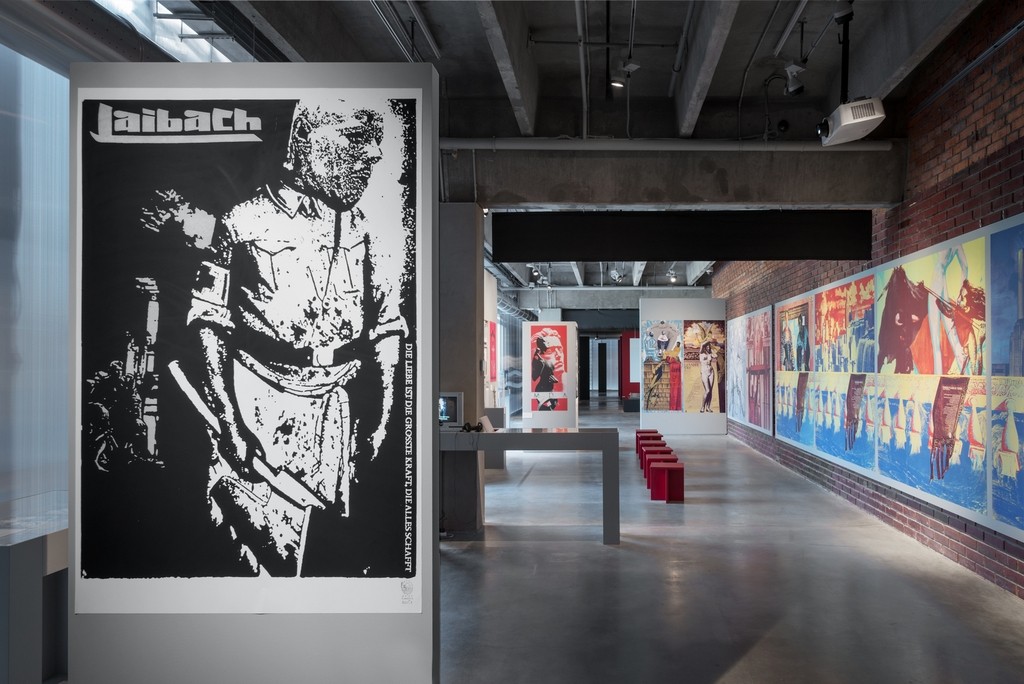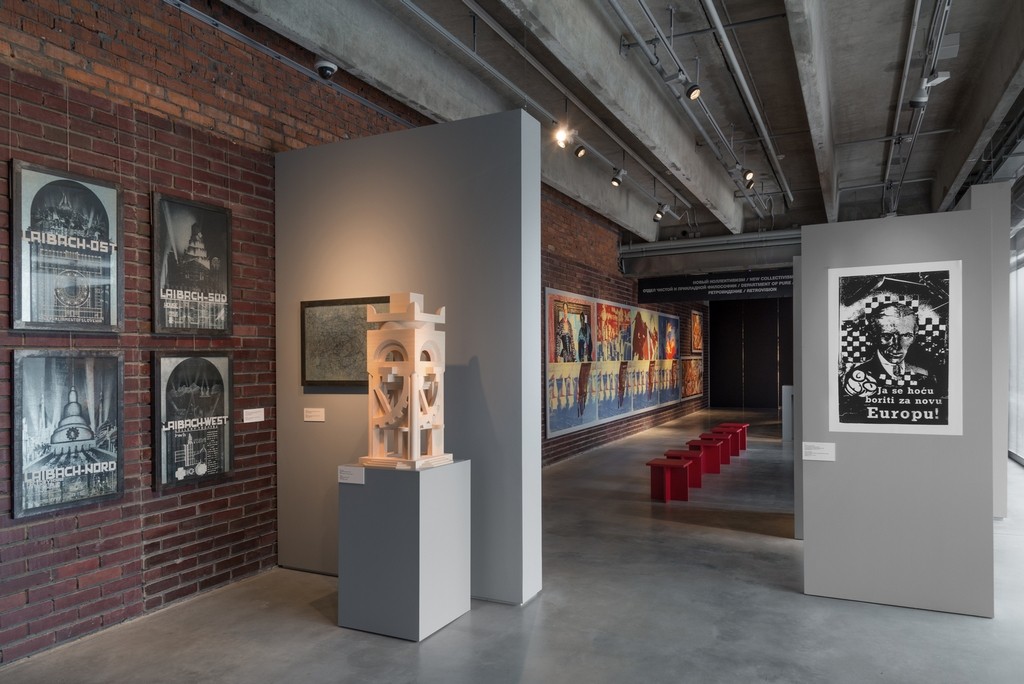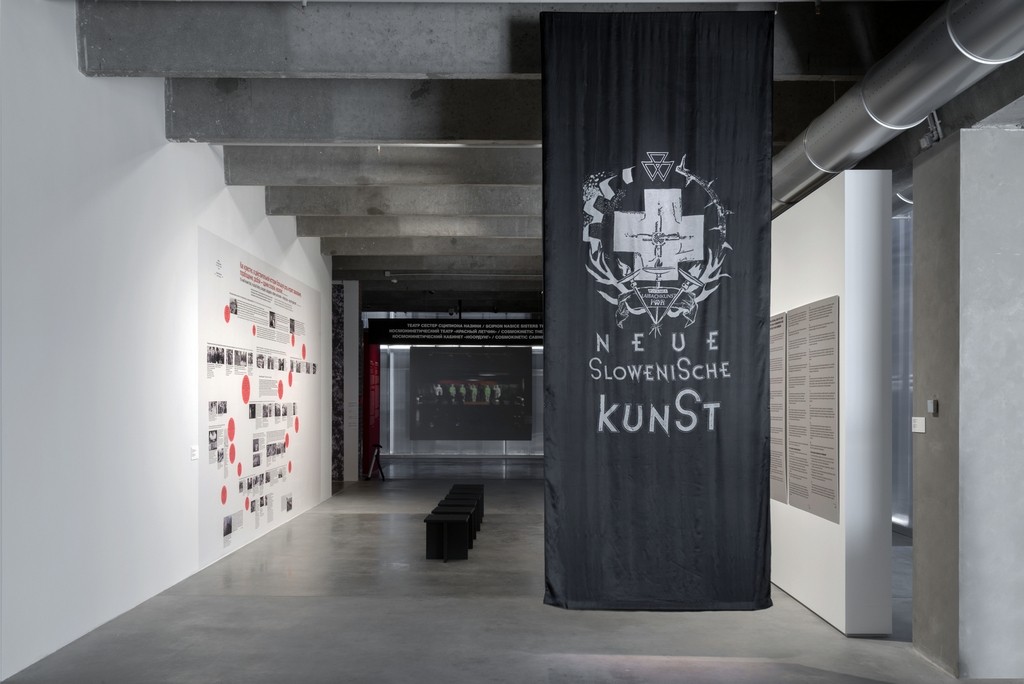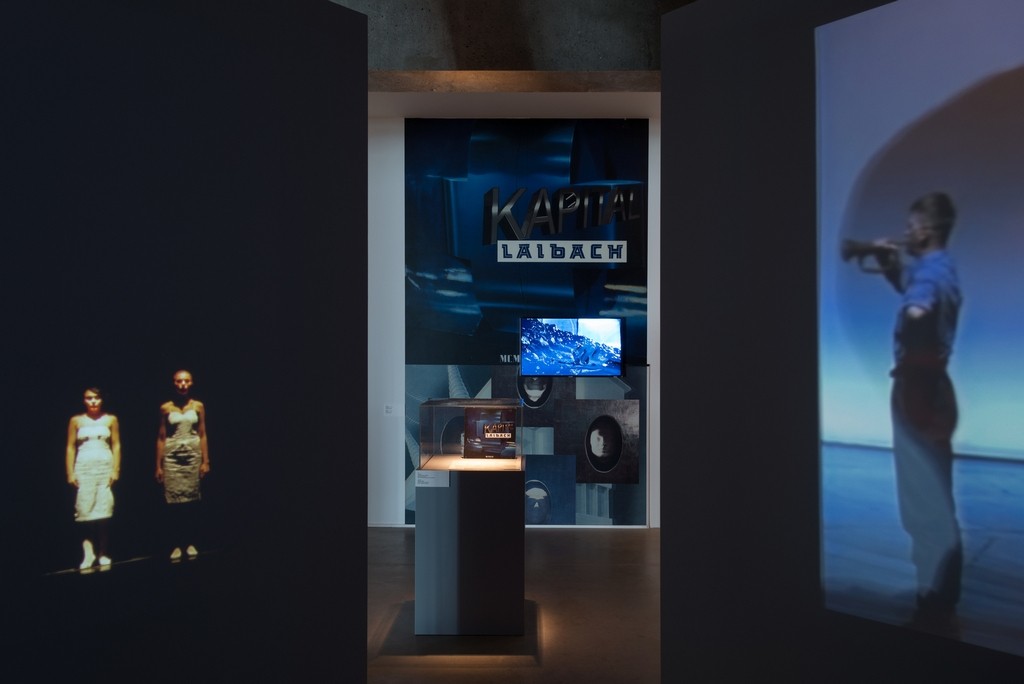NSK: From Kapital To Capital
Neue Slowenische Kunst—An Event of the Final Decade of Yugoslavia
30 Sep - 09 Dec 2016
NSK: FROM KAPITAL TO CAPITAL
Neue Slowenische Kunst—An Event of the Final Decade of Yugoslavia
30 September- 9 December 2016
In fall 2016, Garage Museum of Contemporary Art presented NSK: FROM KAPITAL TO CAPITAL, the first major survey show in Russia of the Slovenian art collective Neue Slowenische Kunst (NSK), developed by the Moderna galerija in Ljubljana. The exhibition traces key events from 1980 to 1992—concerts, shows, theatrical productions, performances, guerrilla actions, public proclamations—by the four core groups that comprised NSK. In 1992, partly in response to the breakup of Yugoslavia, the groups ceased working as a collective and launched the “NSK State in Time,” a utopian formation which describes itself as “the first global state of the Universe.”
The collective Neue Slowenische Kunst (NSK) was founded in 1984 by three groups––the multimedia group Laibach (formed1980), the visual arts group IRWIN (formed 1983) and Scipion Nasice Sisters Theater (1983-1987). In the same year, the three groups founded a fourth group, the design department New Collectivism. Later, NSK established other departments: the Department of Pure and Applied Philosophy (1986), Retrovision (1987), Film (1984), and Builders (1985).
Within the exhibition, three sections follow the individual groups, and one is dedicated to the five departments, expanding the way each enacted the core principles of NSK within its own field. A fifth section looks at the key themes the groups critically examined together which, after the breakup of Yugoslavia and the formation of the new state of Slovenia, would lead to the creation of the “NSK State in Time.”
This first exhibition of the NSK collective is placed within the economic and sociopolitical context of the 1980s, a turbulent decade that preceded the collapse of the old world order and heralded the ever-increasing reach of capitalism. As a unique, self–organized alliance formed in response to this situation, NSK gave an atistic proposal for a different system and a different type of institution, developing its own principles of organization, economy, and terminology for the collective’s artistic practices. The proposal they put forward challenges the simplistic binary opposition of socialist versus capitalist ideology, marking NSK as a global cultural phenomenon transcending its specific time and space.
NSK’s aesthetic and vast theoretical output made use of various art traditions, including the ideas of the Russian avant-garde, which experienced a revival in Yugoslavia in the early 1980s. Each group adapted the avant-garde’s utopian tendencies and iconography to produce individual versions of the “retro” method they adopted as an artistic approach.
In the early 1990s, the collective started an intense relationship with the Moscow art scene which, in 1992, resulted in the organization of the NSK Moscow Embassy—a month-long series of lectures and debates—as part of the “NSK State in Time.” Their exhibition in Moscow twenty-four years later can thus be seen as both a symbolic “return” and an homage to the source of the collective’s unique ideological worldview.
The exhibition is accompanied by a free booklet in Russian and English which provides information on the various groups and their works, as well as a comprehensive introduction to the movement. The English language catalogue, NSK: FROM KAPITAL TO CAPITAL: Neue Slowenische Kunst––An Event of the Final Decade of Yugoslavia, edited by Zdenka Badovinac, Eda Čufer, and Anthony Gardner and published by Moderna galerija and MIT Press, will be available for purchase at Garage Bookshop.
NSK: FROM KAPITAL TO CAPITAL is curated by Zdenka Badovinac, Director of Moderna galerija, Ljubljana. It was first presented at the Moderna galerija in 2015, with a second iteration developed for the Van Abbemuseum, Eindhoven as part of the exhibition The 1980s. Today’s Beginnings? held earlier in 2016. Both exhibitions are part of the five-year program The Uses of Art – the Legacy of 1848 and 1989, organized by L’Internationale.
The exhibition at Garage is organized by Snejana Krasteva, Garage Curator.
Zdenka Badovinac
Zdenka Badovinac is a curator and writer who has been Director of Moderna galerija, Ljubljana since 1993. She initiated the first museum collection of Eastern European art, Moderna galerija’s 2000+ Arteast Collection. Exhibitions include: NSK from Kapital to Capital. Neue Slowenische Kunst–An Event of the Final Decade of Yugoslavia, Moderna galerija, Ljubljana (2015); The Schengen Women, Moderna galerija, Ljubljana (2008); Arteast Collection 2000+23, Moderna galerija, Ljubljana (2006); 7 Sins: Ljubljana–Moscow (with Victor Misiano and Igor Zabel), Moderna galerija, Ljubljana (2004); (un)gemalt, Sammlung Essl, Kunst der Gegenwart, Klosterneuburg/Vienna (2002); Body and the East–From the 1960s to the Present, Exit Art, New York (2001); 2000+ Arteast Collection: The Art of Eastern Europe in Dialogue with the West, Moderna galerija, Ljubljana (2000); unlimited.nl-3, DeAppel, Amsterdam (2000); and Body and the East–From the 1960s to the Present, Moderna galerija, Ljubljana (1998). She was commissioner of the Slovenian Pavilion at the Venice Biennale from 1993 to 1997 and in 2015 and commissioner of the Austrian Pavilion at the 2002 São Paulo Biennial. Badovinac was president of CIMAM from 2011 to 2013.
Snejana Krasteva
Snejana Krasteva is a curator at Garage Museum of Contemporary Art. From 2004 to 2007, she ran the Beijing Tokyo Art Projects gallery before joining Beijing’s Ullens Center for Contemporary Art (2007–2009). She then worked as a curator for Art on the Underground in London. Krasteva joined Garage in 2013, where she was responsible for large-scale commissions by Yin Xiuzhen (2016), Erik Bulatov, and Katharina Grosse (both 2015). She curated the exhibitions Urs Fischer: Small Axe (2016), Grammar of Freedom: Five Lessons (2015), and The Other Side (2014) for Garage. She also co-organized, with staff of the State Tretyakov Gallery in Moscow, the international seminar Who’s Afraid of Kandinsky? Exhibiting Kandinsky in the Twenty-First Century (2016). She is one of the leading curators on the Field Research program, a cross-disciplinary research body whose aim is to produce new material on a wide range of overlooked or underrepresented social and cultural phenomena in Russia.
Neue Slowenische Kunst—An Event of the Final Decade of Yugoslavia
30 September- 9 December 2016
In fall 2016, Garage Museum of Contemporary Art presented NSK: FROM KAPITAL TO CAPITAL, the first major survey show in Russia of the Slovenian art collective Neue Slowenische Kunst (NSK), developed by the Moderna galerija in Ljubljana. The exhibition traces key events from 1980 to 1992—concerts, shows, theatrical productions, performances, guerrilla actions, public proclamations—by the four core groups that comprised NSK. In 1992, partly in response to the breakup of Yugoslavia, the groups ceased working as a collective and launched the “NSK State in Time,” a utopian formation which describes itself as “the first global state of the Universe.”
The collective Neue Slowenische Kunst (NSK) was founded in 1984 by three groups––the multimedia group Laibach (formed1980), the visual arts group IRWIN (formed 1983) and Scipion Nasice Sisters Theater (1983-1987). In the same year, the three groups founded a fourth group, the design department New Collectivism. Later, NSK established other departments: the Department of Pure and Applied Philosophy (1986), Retrovision (1987), Film (1984), and Builders (1985).
Within the exhibition, three sections follow the individual groups, and one is dedicated to the five departments, expanding the way each enacted the core principles of NSK within its own field. A fifth section looks at the key themes the groups critically examined together which, after the breakup of Yugoslavia and the formation of the new state of Slovenia, would lead to the creation of the “NSK State in Time.”
This first exhibition of the NSK collective is placed within the economic and sociopolitical context of the 1980s, a turbulent decade that preceded the collapse of the old world order and heralded the ever-increasing reach of capitalism. As a unique, self–organized alliance formed in response to this situation, NSK gave an atistic proposal for a different system and a different type of institution, developing its own principles of organization, economy, and terminology for the collective’s artistic practices. The proposal they put forward challenges the simplistic binary opposition of socialist versus capitalist ideology, marking NSK as a global cultural phenomenon transcending its specific time and space.
NSK’s aesthetic and vast theoretical output made use of various art traditions, including the ideas of the Russian avant-garde, which experienced a revival in Yugoslavia in the early 1980s. Each group adapted the avant-garde’s utopian tendencies and iconography to produce individual versions of the “retro” method they adopted as an artistic approach.
In the early 1990s, the collective started an intense relationship with the Moscow art scene which, in 1992, resulted in the organization of the NSK Moscow Embassy—a month-long series of lectures and debates—as part of the “NSK State in Time.” Their exhibition in Moscow twenty-four years later can thus be seen as both a symbolic “return” and an homage to the source of the collective’s unique ideological worldview.
The exhibition is accompanied by a free booklet in Russian and English which provides information on the various groups and their works, as well as a comprehensive introduction to the movement. The English language catalogue, NSK: FROM KAPITAL TO CAPITAL: Neue Slowenische Kunst––An Event of the Final Decade of Yugoslavia, edited by Zdenka Badovinac, Eda Čufer, and Anthony Gardner and published by Moderna galerija and MIT Press, will be available for purchase at Garage Bookshop.
NSK: FROM KAPITAL TO CAPITAL is curated by Zdenka Badovinac, Director of Moderna galerija, Ljubljana. It was first presented at the Moderna galerija in 2015, with a second iteration developed for the Van Abbemuseum, Eindhoven as part of the exhibition The 1980s. Today’s Beginnings? held earlier in 2016. Both exhibitions are part of the five-year program The Uses of Art – the Legacy of 1848 and 1989, organized by L’Internationale.
The exhibition at Garage is organized by Snejana Krasteva, Garage Curator.
Zdenka Badovinac
Zdenka Badovinac is a curator and writer who has been Director of Moderna galerija, Ljubljana since 1993. She initiated the first museum collection of Eastern European art, Moderna galerija’s 2000+ Arteast Collection. Exhibitions include: NSK from Kapital to Capital. Neue Slowenische Kunst–An Event of the Final Decade of Yugoslavia, Moderna galerija, Ljubljana (2015); The Schengen Women, Moderna galerija, Ljubljana (2008); Arteast Collection 2000+23, Moderna galerija, Ljubljana (2006); 7 Sins: Ljubljana–Moscow (with Victor Misiano and Igor Zabel), Moderna galerija, Ljubljana (2004); (un)gemalt, Sammlung Essl, Kunst der Gegenwart, Klosterneuburg/Vienna (2002); Body and the East–From the 1960s to the Present, Exit Art, New York (2001); 2000+ Arteast Collection: The Art of Eastern Europe in Dialogue with the West, Moderna galerija, Ljubljana (2000); unlimited.nl-3, DeAppel, Amsterdam (2000); and Body and the East–From the 1960s to the Present, Moderna galerija, Ljubljana (1998). She was commissioner of the Slovenian Pavilion at the Venice Biennale from 1993 to 1997 and in 2015 and commissioner of the Austrian Pavilion at the 2002 São Paulo Biennial. Badovinac was president of CIMAM from 2011 to 2013.
Snejana Krasteva
Snejana Krasteva is a curator at Garage Museum of Contemporary Art. From 2004 to 2007, she ran the Beijing Tokyo Art Projects gallery before joining Beijing’s Ullens Center for Contemporary Art (2007–2009). She then worked as a curator for Art on the Underground in London. Krasteva joined Garage in 2013, where she was responsible for large-scale commissions by Yin Xiuzhen (2016), Erik Bulatov, and Katharina Grosse (both 2015). She curated the exhibitions Urs Fischer: Small Axe (2016), Grammar of Freedom: Five Lessons (2015), and The Other Side (2014) for Garage. She also co-organized, with staff of the State Tretyakov Gallery in Moscow, the international seminar Who’s Afraid of Kandinsky? Exhibiting Kandinsky in the Twenty-First Century (2016). She is one of the leading curators on the Field Research program, a cross-disciplinary research body whose aim is to produce new material on a wide range of overlooked or underrepresented social and cultural phenomena in Russia.







